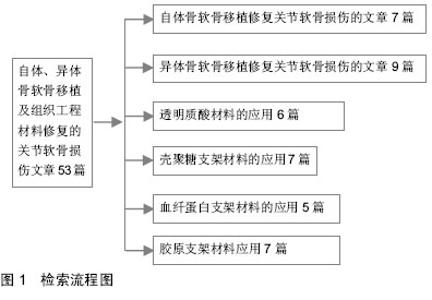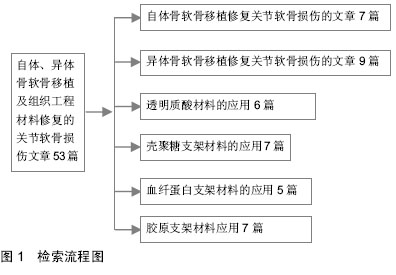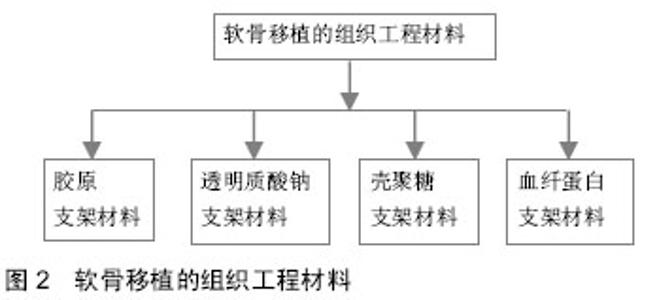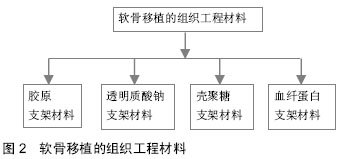Chinese Journal of Tissue Engineering Research ›› 2015, Vol. 19 ›› Issue (34): 5530-5535.doi: 10.3969/j.issn.2095-4344.2015.34.023
Previous Articles Next Articles
Osteochondral autograft and allograft and tissue engineering materials for repair of articular cartilage injury
Zhou Jian-lin, Fang Hong-song, Peng Hao, Deng Shuang, Weng Jin-qing, Liu Feng, Chen Sen, Zhou Guan-jin
- Department of Bone and Joint Surgery, Renmin Hospital of Wuhan University, Wuhan 430060, Hubei Province, China
-
Online:2015-08-20Published:2015-08-20 -
Contact:Zhou Jian-lin, Department of Bone and Joint Surgery, Renmin Hospital of Wuhan University, Wuhan 430060, Hubei Province, China -
About author:Zhou Jian-lin, M.D., Attending physician, Department of Bone and Joint Surgery, Renmin Hospital of Wuhan University, Wuhan 430060, Hubei Province, China -
Supported by:the National Natural Science Foundation of China, No. 81301592
CLC Number:
Cite this article
Zhou Jian-lin, Fang Hong-song, Peng Hao, Deng Shuang, Weng Jin-qing, Liu Feng, Chen Sen, Zhou Guan-jin. Osteochondral autograft and allograft and tissue engineering materials for repair of articular cartilage injury [J]. Chinese Journal of Tissue Engineering Research, 2015, 19(34): 5530-5535.
share this article
| [1] Beris AE, Lykissas MG, Papageorgiou CD, et al. Advances in articular cartilage repair. Injury. 2005;36 Suppl 4: S14-S23. [2] Gobbi A, Nunag P, Malinowski K. Treatment of full thickness chondral lesions of the knee with microfracture in a group of athletes. Knee Surg Sports Traumatol Arthrosc. 2005;13(3): 213-221. [3] Mano JF, Reis RL. Osteochondral defects: present situation and tissue engineering approaches. J Tissue Eng Regen Med. 2007;1(4):261-273. [4] Wolfe MM, Lichtenstein DR, Singh G. Gastrointestinal toxicity of nonsteroidal antiinflammatory drugs. N Engl J Med, 1999; 340(24):1888-1899. [5] Kotz R, Kolarz G. Intra-articular hyaluronic acid: duration of effect and results of repeated treatment cycles. Am J Orthop (Belle Mead NJ). 1999;28(11 Suppl):5-7. [6] Martin I, Miot S, Barbero A, et al. Osteochondral tissue engineering. J Biomech. 2007;40(4):750-765. [7] Azuma Y, Ito M, Harada Y, et al. Low intensity pulsed ultrasound accelerates rat femoralfracture healing by acting on the various cellular reactions in the fracture callus. J Bone Miner Res. 2001;16(4):671-680. [8] Hubbard MJ. Articular debridement versus washout for degeneration of the medial femoral condyle: a five-year study. J Bone Joint Surg Br. 1996;78(2):217-219. [9] Knutsen G, Engebretsen L, Ludvigsen TC, et al. Autologous chondrocyte implantation compared with microfracture in the knee. A randomized trial. J Bone Joint Surg Am. 2004;86-A(3): 455-464. [10] Jackson RW, Dieterichs C. The results of arthroscopic lavage and debridement ofosteoarthritic knees based on the severity of degeneration: a 4-to 6-year symptomaticfollow-up. Arthroscopy. 2003;19(1):13-20. [11] Barber FA, Chow JC. Arthroscopic osteochondral transplantation: histologic results. Arthroscopy. 2001;17(8): 832-835. [12] Buckwalter JA, Mankin HJ. Articular cartilage: tissue design and chondrocyte-matrix interactions. Instr Course Lect. 1998; 47:477-486. [13] McCulloch PC, Kang RW, Sobhy MH, et al. Prospective evaluation of prolonged fresh osteochondral allograft transplantation of the femoral condyle. Am J Sports Med. 2007;35(3):411-420. [14] Gross AE, Agnidis Z, Hutchison CR. Osteochondral defects of the talus treated with fresh osteochondral allograft transplantation. Foot Ankle Int. 2001;22(5)385-391. [15] 郑荣宗,吴伟东,应锦河,等.关节镜下自体骨软骨移植治疗膝关节软骨缺损[J].中国骨与关节损伤杂志,2014,29(10):1050-1051. [16] 张利恒,桑平,李光淳,等.关节镜下自体软骨移植修复中青年软骨缺损疗效观察[J].吉林医学,2008,29(23):2145-2146. [17] Czitrom AA, Keating S, Gross AE. The viability of articular cartilage in fresh osteochondral allografts after clinical transplantation. J Bone Joint Surg Am. 1990;72(4)574-581. [18] Steadman JR, Briggs KK, Rodrigo JJ,et al. Outcomes ofmicrofracturefor traumatic chondral defects of the knee: average 11-year follow-up. Arthroscopy. 2003;19(5):477-484. [19] Willers C, Chen J, Wood D, et al. Autologous chondrocyte implantation with collagen bioscaffold for the treatment of osteochondral defects in rabbits. Tissue Eng. 2005;11(7-8): 1065-1076. [20] Grande DA, Pitman MI, Peterson L, et al. The repair of experimentally produced defects in rabbit articular cartilage by autologous chondrocyte transplantation. J Orthop Res. 1989;7(2):208-218. [21] Tratting S, Mamisch TC, Pinker K, et al. Differentiating normal hyaline cartilage from post-surgical repair tissue using fast gradient echo imaging in delayed gadolinium-enhanced MRI (dGEMRIC) at 3 Tesla. Eur Radiol. 2008;18(6):1251-1259. [22] Marcacci M, Zaffagnini S, Kon E, et al. Arthroscopic autologous chondrocyte transplantation: technical note. Knee Surg Sports Traumatol Arthrosc. 2002;10(3):154-159. [23] Brittberg M, Lindahl A, Nilsson A, et al. Treatment of deep cartilage defects in the knee with autologous chondrocyte transplantation. New Eng J Med. 1994;331(14):889-895. [24] Hoemann CD, Hurtig M, Rossomach E, et al. Chitosan-glycerol phosphate/blood implants improve hyaline cartilage repair in ovine microfracture defects. J Bone Joint Surg Am. 2005;87(12):2671-2686. [25] 周程沛,曹安,方春抒,等.新鲜自体与异体骨软骨移植修复免关节软骨缺损的比较义[J].中国组织工程研究与临床康复,2009, 13(15):2833-2836. [26] Chevrier A, Hoemann CD, Sun J, et al. Chitosan-glycerol phosphate-blood implants increase cell recruitment, transient vascularisation and subchondral bone remodeling in drilled cartilage defects. Osteoarthritis Cartilage. 2007;15(3): 316-327. [27] Peterson L, Minas T, Brittberg M, et al. Two- to 9-year outcome after autologous chondrocyte transplantation of the knee. Clin Orthop Relat Res. 2000;(374):212-234. [28] Fragonas E, Valente M, Pozzi-Mucelli M, et al. Articular cartilage repair in rabbits by using suspensions of allogenic chondrocytes in alginate. Biomaterials. 2000;21(8):795-801. [29] Bartlett W, Skinner JA, Gooding CR, et al. Autologous chondrocyte implantation versusmatrix-induced autologous chondrocyte implantation for osteochondral defects of the knee: aprospective, randomised study. J Bone Joint Surg Br. 2005;87(5):640-645. [30] Almqvist KF, Dhollander AA, Verdonk PC, et al. Treatment of cartilage defects in the knee using alginate beads containing human mature allogenic chondrocytes. Am J Sports Med. 2009;37(10):1920-1929. [31] 项舟,胡炜,孔清泉,等.骨髓间充质干细胞种植Ⅰ型胶原支架材料修复关节软骨缺损的初步研究[J].中国修复重建外科杂志,2006, 20(2):148-154. [32] Madsen BL, Noer HH, Carstensen JP, et al. Long-term results of periosteal transplantation in osteochondritis dissecans of the knee. Orthopedics. 2000;23(3):223-226. [33] Kim MS, Hwang NS, Lee J, et al. Musculoskeletal differentiation of cells derivedfrom human embryonic germ cells. Stem Cells. 2005;23(1):113-123. [34] 崔运利,王富友,谭洪波,等.利用胶原和聚乙烯醇构建组织工程软骨支架[J].第三军医大学学报,2010,32(17):1820-1823. [35] 朱凌云,王彦平,石宗利,等.聚磷酸钙纤维/明胶软骨组织工程支架复合材料的制备及性能表征[J].中国组织工程研究与临床康复,2010,9(47):9265-9268. [36] Veilleux N, Spector M. Effects of FGF-2 and IGF-1 on adult canine articularchondrocytes in type II collagen-glycosaminoglycan scaffolds in vitro. Osteoarthritis Cartilage. 2005;13(4):278-286. [37] Saha K, Pollock JF, Schaffer DV, et al. Designing synthetic materials to control stem cell phenotype. Curr Opin Chem Biol. 2007;11(4):381-387. [38] Li WJ, Tuli R, Okafor C, et al. A three-dimensional nanofibrous scaffold for cartilagetissue engineering using human mesenchymal stem cells. Biomaterials. 2005;26(6):599-609. [39] Grande DA, Mason J, Light E, et al. Stem cells as platforms for delivery of genes to enhance cartilage repair.J Bone Joint Surg Am. 2003;85-A Suppl 2:111-116. [40] 刘少英,陈建英,陈倩倩,等.以交联透明质酸钠为支架体外构建组织工程软骨[J].中国组织工程研究,2014,(8):1191-1197. [41] 刘春栋,张志光,苏凯,等.透明质酸改性聚乳酸支架组织工程软骨的构建[J].广东牙病防治,2012,20(3):124-129. [42] Sato M, Ishihara M, Ishihara M, et al. Effects of growth factors on heparin-carrying polystyrene-coated atelocollagen scaffold for articular cartilage tissue engineering. J Biomed Mater Res B Appl Biomater. 2007;83(1):181-188. [43] 杨强,彭江,卢世璧,等.新型脱细胞软骨基质三维多孔支架的制备[J].中国修复重建外科杂志,2008,3:359-363. [44] Nishida T, Kubota S, Kojima S, et al. Regeneration of defects in articular cartilage in rat knee joints by CCN2 ( connective tissue growth factor). J Bone Miner Res. 2004;19(8):1308-1319. [45] Aoyama E, Hattori T, Hoshijima M, et al. N-terminal domains of CCN family 2 /connective tissue growth factor bind to aggrecan. Biochem J. 2009;420(3):413-420. [46] 郭忠鹏,彭超,蒋电明,等.三种生物材料修复兔关节软骨缺损的性能对比[J].中国组织工程研究与临床康复,2010,16:2870-2874. [47] 瞿桂友.壳聚糖制作组织工程软骨支架的研究[J].大家健康(中旬版),2013,(10):195-196. [48] 夏万尧,曹谊林,商庆新,等.壳聚糖作为组织工程软骨支架的实验研究[J].中华显微外科杂志,2002,25(1):34-37. [49] Okano H, Tomita N, Ikada Y, et al. Effects of 120 mT static magnetic field on TGF-beta1-inhibited endothelial tubular formation in vitro. Bioelectromagnetics. 2007;28(6):497-499. [50] Madry H, Zurakowski D, Trippel SB. Overexpression of human insulin-like growth factor-I promotes new tissue formation in an ex vivo model of articular chondrocyte transplantation. Gene Ther. 2001;8(19):1443-1449. [51] Oligino T, Ghivizzani S, Wolfe D, et al. Intra-articular delivery of a herpes simplex virus IL-1Ra gene vector reduces inflammation in a rabbit model of arthritis. Gene Ther. 1999;6(10):1713-1720. [52] 林荔军,朱立新,丁超,等.BMP-6改良纤维蛋白原支架软骨模块修复兔关节软骨缺损的实验研究[J].实用预防医学,2008, 15(4):994-996. [53] Kwon GY, Jeong J, Woo JK, et al. Co-expression of bfl-1 enhances host response in the herpes simplex virus-thymidine kinase/ganciclovir gene therapy system. Biochem Biophys Res Commun. 2003;303(3):756-763. |
| [1] | Zhang Tongtong, Wang Zhonghua, Wen Jie, Song Yuxin, Liu Lin. Application of three-dimensional printing model in surgical resection and reconstruction of cervical tumor [J]. Chinese Journal of Tissue Engineering Research, 2021, 25(9): 1335-1339. |
| [2] | Peng Zhihao, Feng Zongquan, Zou Yonggen, Niu Guoqing, Wu Feng. Relationship of lower limb force line and the progression of lateral compartment arthritis after unicompartmental knee arthroplasty with mobile bearing [J]. Chinese Journal of Tissue Engineering Research, 2021, 25(9): 1368-1374. |
| [3] | Huang Dengcheng, Wang Zhike, Cao Xuewei. Comparison of the short-term efficacy of extracorporeal shock wave therapy for middle-aged and elderly knee osteoarthritis: a meta-analysis [J]. Chinese Journal of Tissue Engineering Research, 2021, 25(9): 1471-1476. |
| [4] | Wu Xun, Meng Juanhong, Zhang Jianyun, Wang Liang. Concentrated growth factors in the repair of a full-thickness condylar cartilage defect in a rabbit [J]. Chinese Journal of Tissue Engineering Research, 2021, 25(8): 1166-1171. |
| [5] | Li Jiacheng, Liang Xuezhen, Liu Jinbao, Xu Bo, Li Gang. Differential mRNA expression profile and competitive endogenous RNA regulatory network in osteoarthritis [J]. Chinese Journal of Tissue Engineering Research, 2021, 25(8): 1212-1217. |
| [6] | Geng Qiudong, Ge Haiya, Wang Heming, Li Nan. Role and mechanism of Guilu Erxianjiao in treatment of osteoarthritis based on network pharmacology [J]. Chinese Journal of Tissue Engineering Research, 2021, 25(8): 1229-1236. |
| [7] | Liu Xiangxiang, Huang Yunmei, Chen Wenlie, Lin Ruhui, Lu Xiaodong, Li Zuanfang, Xu Yaye, Huang Meiya, Li Xihai. Ultrastructural changes of the white zone cells of the meniscus in a rat model of early osteoarthritis [J]. Chinese Journal of Tissue Engineering Research, 2021, 25(8): 1237-1242. |
| [8] | Zeng Yanhua, Hao Yanlei. In vitro culture and purification of Schwann cells: a systematic review [J]. Chinese Journal of Tissue Engineering Research, 2021, 25(7): 1135-1141. |
| [9] | He Xiangzhong, Chen Haiyun, Liu Jun, Lü Yang, Pan Jianke, Yang Wenbin, He Jingwen, Huang Junhan. Platelet-rich plasma combined with microfracture versus microfracture in the treatment of knee cartilage lesions: a meta-analysis [J]. Chinese Journal of Tissue Engineering Research, 2021, 25(6): 964-969. |
| [10] | Liu Xin, Yan Feihua, Hong Kunhao. Delaying cartilage degeneration by regulating the expression of aquaporins in rats with knee osteoarthritis [J]. Chinese Journal of Tissue Engineering Research, 2021, 25(5): 668-673. |
| [11] | Ma Zetao, Zeng Hui, Wang Deli, Weng Jian, Feng Song. MicroRNA-138-5p regulates chondrocyte proliferation and autophagy [J]. Chinese Journal of Tissue Engineering Research, 2021, 25(5): 674-678. |
| [12] | Cao Xuhan, Bai Zixing, Sun Chengyi, Yang Yanjun, Sun Weidong. Mechanism of “Ruxiang-Moyao” herbal pair in the treatment of knee osteoarthritis based on network pharmacology [J]. Chinese Journal of Tissue Engineering Research, 2021, 25(5): 746-753. |
| [13] | Li Yonghua, Feng Qiang, Tan Renting, Huang Shifu, Qiu Jinlong, Yin Heng. Molecular mechanism of Eucommia ulmoides active ingredients treating synovitis of knee osteoarthritis: an analysis based on network pharmacology [J]. Chinese Journal of Tissue Engineering Research, 2021, 25(5): 765-771. |
| [14] | Song Shan, Hu Fangyuan, Qiao Jun, Wang Jia, Zhang Shengxiao, Li Xiaofeng. An insight into biomarkers of osteoarthritis synovium based on bioinformatics [J]. Chinese Journal of Tissue Engineering Research, 2021, 25(5): 785-790. |
| [15] | Deng Zhenhan, Huang Yong, Xiao Lulu, Chen Yulin, Zhu Weimin, Lu Wei, Wang Daping. Role and application of bone morphogenetic proteins in articular cartilage regeneration [J]. Chinese Journal of Tissue Engineering Research, 2021, 25(5): 798-806. |
| Viewed | ||||||
|
Full text |
|
|||||
|
Abstract |
|
|||||



